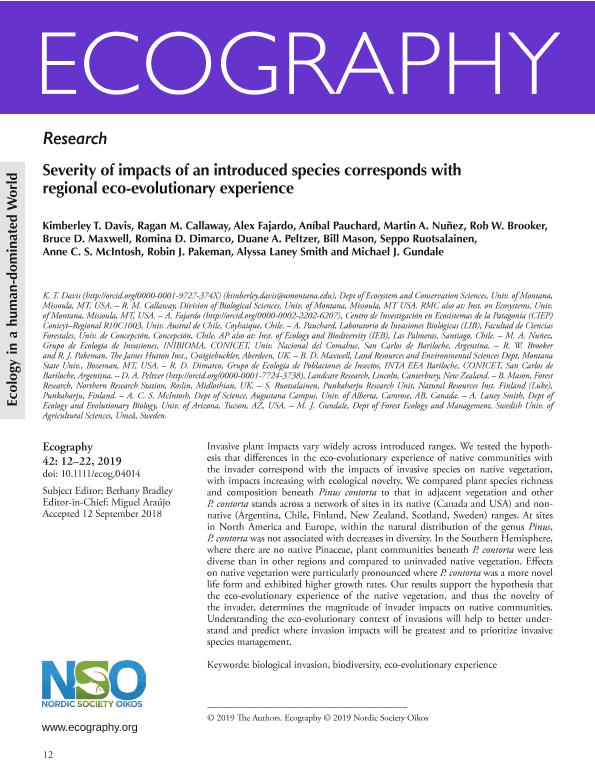Artículo
Severity of impacts of an introduced species corresponds with regional eco-evolutionary experience
Davis, Kimberley T.; Callaway, Ragan; Fajardo, Alex; Pauchard, Aníbal; Nuñez, Martin Andres ; Brooker, Rob; Maxwell, Bruce; Dimarco, Romina Daniela
; Brooker, Rob; Maxwell, Bruce; Dimarco, Romina Daniela ; Peltzer, Duane; Mason, Bill; Ruotsalainen, Seppo; McIntosh, Anne; Pakeman, Robin; Smith, Alyssa Laney; Gundale, Michael
; Peltzer, Duane; Mason, Bill; Ruotsalainen, Seppo; McIntosh, Anne; Pakeman, Robin; Smith, Alyssa Laney; Gundale, Michael
 ; Brooker, Rob; Maxwell, Bruce; Dimarco, Romina Daniela
; Brooker, Rob; Maxwell, Bruce; Dimarco, Romina Daniela ; Peltzer, Duane; Mason, Bill; Ruotsalainen, Seppo; McIntosh, Anne; Pakeman, Robin; Smith, Alyssa Laney; Gundale, Michael
; Peltzer, Duane; Mason, Bill; Ruotsalainen, Seppo; McIntosh, Anne; Pakeman, Robin; Smith, Alyssa Laney; Gundale, Michael
Fecha de publicación:
01/2019
Editorial:
Wiley Blackwell Publishing, Inc
Revista:
Ecography
ISSN:
0906-7590
e-ISSN:
1600-0587
Idioma:
Inglés
Tipo de recurso:
Artículo publicado
Clasificación temática:
Resumen
Invasive plant impacts vary widely across introduced ranges. We tested the hypothesis that differences in the eco-evolutionary experience of native communities with the invader correspond with the impacts of invasive species on native vegetation, with impacts increasing with ecological novelty. We compared plant species richness and composition beneath Pinus contorta to that in adjacent vegetation and other P. contorta stands across a network of sites in its native (Canada and USA) and non-native (Argentina, Chile, Finland, New Zealand, Scotland, Sweden) ranges. At sites in North America and Europe, within the natural distribution of the genus Pinus, P. contorta was not associated with decreases in diversity. In the Southern Hemisphere, where there are no native Pinaceae, plant communities beneath P. contorta were less diverse than in other regions and compared to uninvaded native vegetation. Effects on native vegetation were particularly pronounced where P. contorta was a more novel life form and exhibited higher growth rates. Our results support the hypothesis that the eco-evolutionary experience of the native vegetation, and thus the novelty of the invader, determines the magnitude of invader impacts on native communities. Understanding the eco-evolutionary context of invasions will help to better understand and predict where invasion impacts will be greatest and to prioritize invasive species management.
Palabras clave:
BIODIVERSITY
,
BIOLOGICAL INVASION
,
ECO-EVOLUTIONARY EXPERIENCE
Archivos asociados
Licencia
Identificadores
Colecciones
Articulos(INIBIOMA)
Articulos de INST. DE INVEST.EN BIODIVERSIDAD Y MEDIOAMBIENTE
Articulos de INST. DE INVEST.EN BIODIVERSIDAD Y MEDIOAMBIENTE
Citación
Davis, Kimberley T.; Callaway, Ragan; Fajardo, Alex; Pauchard, Aníbal; Nuñez, Martin Andres; et al.; Severity of impacts of an introduced species corresponds with regional eco-evolutionary experience; Wiley Blackwell Publishing, Inc; Ecography; 42; 1; 1-2019; 12-22
Compartir
Altmétricas



